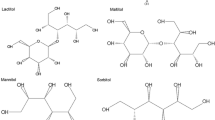Abstract
Type of carbohydrate and glycemic index of traditional foods is still a challenge in nutritional management of diabetics. This study was conducted to determine the GI of pasta (ordinary and infused), made from either nol (common wheat) or semolina (durum wheat) flour, compared to white rice in subjects. Twelve healthy volunteers with body mass index 23.5 ± 1.45 kg/m2 and age 36 ± 2.85 years participated in this study. Twelve hours overnight fasting capillary blood samples were collected from subjects at baseline by finger stick using a sterile lancet pen immediately before ingestion of either 50 g of d-glucose anhydrate dissolved in 300 ml distilled water, 192.3 g cooked pasta or 185.2 g of rice (50 g carbohydrate) alongside 300 ml water. Blood samples were collected again at 0, 15, 30, 45, 60, 90 and 120 min. All subjects consumed the test meals at 1-week interval. The standard glucose solution was administered at the first and fourth week of study. Blood samples were analysed using an Accu-Chek Aviva Blood Glucose Monitor. The area under the curve was calculated as the incremental area under the blood glucose response curve for each test in each individual. The GI values were determined according to FAO/WHO standard methods. This study indicated that the GI of ordinary pasta made from semolina {47} is significantly lower than nol flour pasta {68} or cooked rice {73}. There was a reverse, but non-significant, difference between the GI of semolina-infused pasta {63} versus nol-infused pasta {60}. Glycemic index for pasta (semolina and non-infused) was significantly less than that of nol wheat pasta, cooked rice and white bread. This study underscores the importance of consuming ordinary pasta made from semolina as part of a low GI diet for controlling blood glucose levels.



Similar content being viewed by others
References
Lefloch J, Perlemuter L (1992) Glycemic index of foods. Presse Méd (Paris, France: 1983) 21:2097
Garrow JS, Ralph A, James WPT (2000) Human nutrition and dietetics, 10th edn. Harcourt Publisher Limited, UK.
Ludwig DS, Eckel RH (2002) The glycemic index at 20 y. Am J Clin Nutr 76:264S
Sieri S, Krogh V, Berrino F, Evangelista A, Agnoli C, Brighenti F, Pellegrini N, Palli D, Masala G, Sacerdote C, Veglia F, Tumino R, Frasca G, Grioni S, Pala V, Mattiello A, Chiodini P, Panico S (2010) Dietary glycemic load and index and risk of coronary heart disease in a large Italian cohort. The EPICOR study. Arch Intern Med 170(7):640–647
Jenkins DJA, Kendall CWC, Augustin LSA, Franceschi S, Hamidi M, Marchie A, Jenkins AL, Axelsen M (2002) Glycemic index: overview of implications in health and disease. Am J Clin Nutr 76(suppl):266S–273S
Foster-Powell K, Holt SHA, Brand-Miller JC (2002) International table of glycemic index and glycemic load values: 2002. Am J Clin Nutr 76:5
Brand Miller JC (2003) Glycemic load and chronic disease. Nutr Rev 61:S49–S55
Hannon RA, Pooler C, Porth CM (2009) Type of starch, cooking, food processing, fat content of food, acid content of food. In: Porth CM (ed) Pathophysiology: concepts of altered health states. Lippincott Williams & Wilkins, Philadelphia, p 1632
Jenkins D, Wolever T, Jenkins A (1988) Starchy foods and glycemic index. Diabetes Care 11:149
Levis Sh P, McGowan CA, McAuliffe FM (2010) Methodology for adding and amending glycemic index values to a nutrition analysis package. Br J Nutr 105:1–16. doi:10.1017/S0007114510004769
Chillo S, Ranawana DV, Pratt M, Henry CJ (2011) Glycemic response and glycemic index of semolina spaghetti enriched with barley b-glucan. Nutrition 27:653–658
Bustos MC, Perez GT, Edel León A (2011) Sensory and nutritional attributes of fibre-enriched pasta. LWT Food Sci Technol 44:1429–1434
Chillo S, Monro JA, Mishra S, Henry CJ (2010) Effect of incorporating legume flour into semolina spaghetti on its cooking quality and glycaemic impact measured in vitro. Int J Food Sci Nutr 61(2):149–160
Bourdon I, Yokoyama W, Davis P, Hudson C, Backus R, Richter D, Knuckles B, Schneeman BO (1999) Postprandial lipid, glucose, insulin, and cholecystokinin responses in men fed barley pasta enriched with beta-glucan. Am J Clin Nutr 69:55–63
Ellison JM, Stegmann JM, Colner SL, Michael RH, Sharma MK, Ervin KR, Horwitz DL (2002) Rapid changes in postprandial blood glucose produce concentration differences at finger, forearm, and thigh sampling sites. Diabetes Care 25:961
Vander Valk PR, Vander SchatteOlivier-Steding I, Wientjes KJC, Schoonen AJ, Hoogenberg K et al (2002) Alternative-site blood glucose measurement at the abdomen. Diabetes Care 25:2114
Kestin M, Moss R, Clifton PM, Nestel PJ (1990) Comparative effects of three cereal brans on plasma lipids, blood pressure, and glucose metabolism in mildly hypercholesterolemic men. Am J Clin Nutr 52:661
Hollenbeck C, Coulston A, Reaven G (1986) To what extent does increased dietary fiber improve glucose and lipid metabolism in patients with noninsulin-dependent diabetes mellitus (NIDDM)? Am J Clin Nutr 43:16
Hallfrisch J, Schlfield DJ, Behall KM (1995) Diets containing soluble oat extracts improve glucose and insulin responses of moderately hypercholesterolemic men and women. Am J Clin Nutr 61:379
Hajifaraji M, Leeds AR (2008) The effect of high and low glycemic index diets on urinary chromium in healthy individuals: a cross-over study. Arch Iran Med 11(1):57–64
Acknowledgments
The authors thank Zar Macaron Co. for financial support to conduct this research project and also appreciate all volunteers who participate in this study. This study was financially supported by National Nutrition and Food Technology Research Institute.
Conflict of interest
None.
Author information
Authors and Affiliations
Corresponding authors
About this article
Cite this article
Hajifaraji, M., Rezvani, V., Yaghoobi, A.S. et al. Glycemic indices of three commonly consumed foods: a clinical trial in Iranian healthy adults. Mediterr J Nutr Metab 5, 253–257 (2012). https://doi.org/10.1007/s12349-012-0094-y
Received:
Accepted:
Published:
Issue Date:
DOI: https://doi.org/10.1007/s12349-012-0094-y




